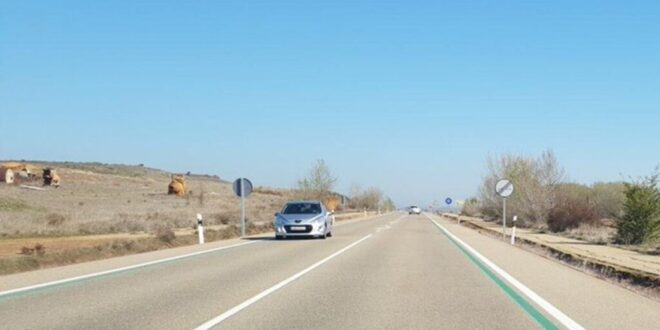The new green lines are intended to slow drivers down on Spanish roads by creating an effect of visual narrowing.
Credit : SocialDrive_es/X
Most drivers don’t know why they have started to appear across the country.
You are not seeing things if you have noticed green lines along the white edge of some roads in Spain. It is also not a recent road design trend. The new tool is being used by Spain’s Traffic Authority (DGT) to reduce road accidents.
But what are they really saying? What do they mean? And why have they appeared now? Let’s clear it up before your next drive leaves you wondering what on earth is going on with the tarmac.
The green lines on Spanish highways are intended to reduce speed
Here’s how it works: the green lines are painted alongside the white lines to give the impression that the road is smaller than it is. It sounds strange, doesn’t it? It works. DGT claims that the visual trick causes drivers to instinctively reduce their accelerator pedal pressure, without realizing why.
They’re being used in areas that are known to be dangerous — the kinds of roads where a small misjudgement can have big consequences. It is hoped that the tighter road will make drivers more cautious.
It’s an indirect way to say, Slow down! There are no flashing warnings or aggressive signs. A thin green line will encourage you to drive more safely.
The first trial run took place on a couple of regional roads in Castilla y León, and now these markings are being gradually introduced across the country.
Understand Spain’s double-white line rule for safer driving
When we are talking about road markings, let’s not forget the double solid-white line. It’s the one that is often overlooked but shouldn’t. This line is a complete no-overtaking rule in both directions. There are only two exceptions: passing bikes, mopeds broken down vehicles, pedestrians, or animals when it’s safe.
These tend to be seen on roads where there are tight bends or poor visibility. They’re also common in areas with a high accident rate. You should stay in the lane if you encounter one.
Spain’s High-Risk Roads: When caution is crucial
DGT doesn’t paint roads at random. They keep close tabs on which stretches of road are statistically the most dangerous — these are known as Tramos de Concentración de Accidentes (TCA), or in plain English, accident black spots.
The segments that make up this list are typically no more than three kilometers long, but have seen more accidents than other roads. DGT considers factors such as accident rates and traffic volumes when deciding which roads to include on the list. Once they do, those areas become priority zones for safety upgrades — like new signs, better infrastructure, or yes, those green lines we mentioned earlier.
Next time you notice a double line of white or green on the road, pay attention. It’s not just paint — it’s the DGT’s quiet way of telling you, ‘Pay attention to this’
After all, an extra dose of caution in the correct place can make all the different.
More news coming soon from Spain
 Costa News Spain Breaking News | English News in Spain.
Costa News Spain Breaking News | English News in Spain.





